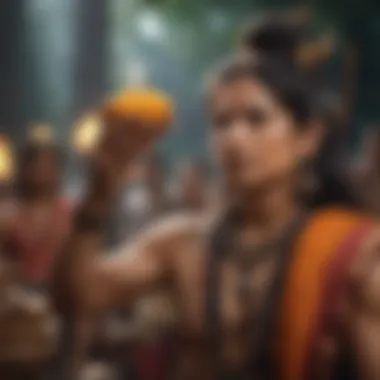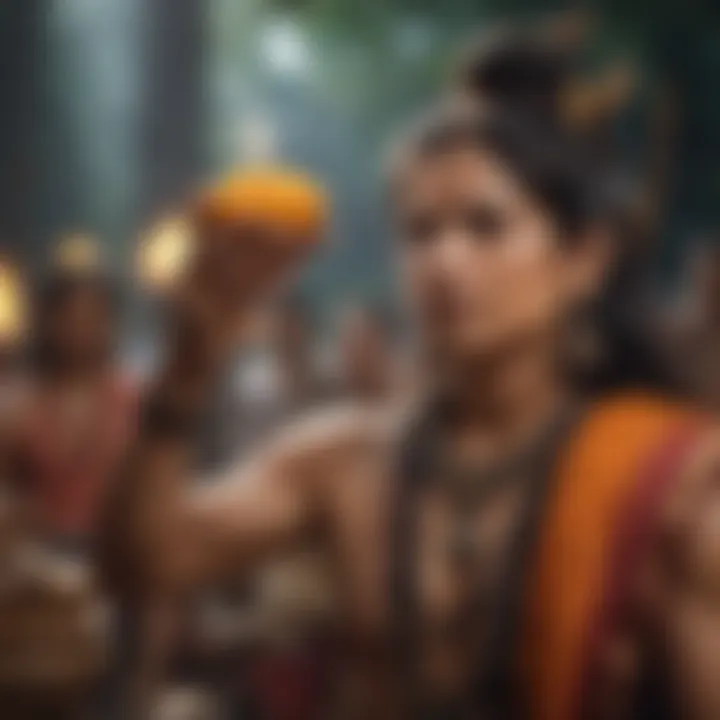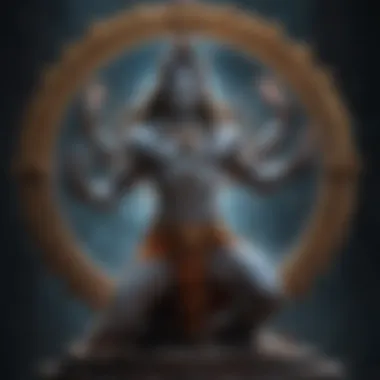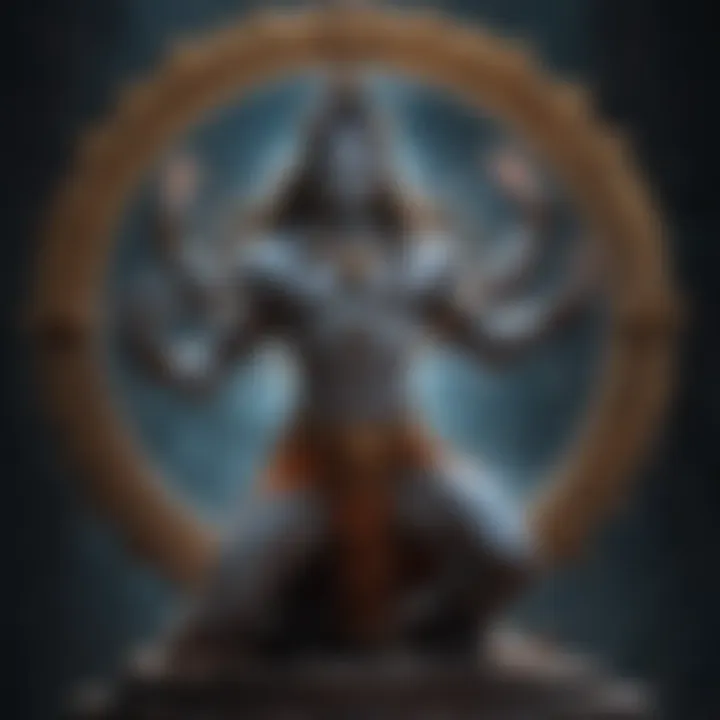The Significance of Mahashivratri: Meaning and Practices


Intro
Mahashivratri, a pivotal festival in Hindu culture, encapsulates profound spiritual significance. This occasion marks the convergence of Shiva and Shakti, embodying a balance of divine energies that stimulates both reflection and renewal. As devotees engage in rituals and fasting, they seek to deepen their connection with the cosmic principles represented by these energies.
The festival is not just a religious observance; it also serves as a means to understand the self and to undergo personal transformation. The practices associated with Mahashivratri, which include extended prayer, chanting, and meditation, invite individuals to experience their inner divinity. This observance offers insights into the dynamics of existence, thus fostering a greater understanding of one's spiritual journey.
By exploring the historical roots, cultural practices, and psychological impacts of Mahashivratri, we begin to appreciate its relevance in contemporary spirituality. The emphasis on renewal and transformation resonates deeply in today's fast-paced world, where many seek meaning and purpose in daily life.
Understanding Mahashivratri allows us to grasp its intricate relationship with personal growth, communal ties, and broader cosmic movements. Through this inquiry, we can observe how the festival reflects universal themes that continue to inspire seekers across time and space.
Understanding the Zodiac
Overview of Zodiac Signs
The twelve zodiac signs play an essential role in understanding individual personalities and cosmic influences. Each sign holds distinct attributes that resonate with various aspects of our lives.
Sign Traits and Characteristics
- Aries: Fiery and enthusiastic
- Taurus: Grounded and reliable
- Gemini: Adaptable and communicative
- Cancer: Intuitive and nurturing
- Leo: Charismatic and confident
- Virgo: Analytical and meticulous
- Libra: Diplomatic and fair-minded
- Scorpio: Intense and passionate
- Sagittarius: Adventurous and optimistic
- Capricorn: Disciplined and ambitious
- Aquarius: Innovative and independent
- Pisces: Compassionate and artistic
Elemental Qualities
Each zodiac sign is categorized into one of the four elemental qualities:
- Fire: Aries, Leo, Sagittarius
- Earth: Taurus, Virgo, Capricorn
- Air: Gemini, Libra, Aquarius
- Water: Cancer, Scorpio, Pisces
These elemental associations offer further insight into the nature of each sign, enriching the understanding of personal dynamics and interactions.
Astrological Insights
Current Astrological Trends
In recent years, shifts in planetary alignments have sparked significant changes in societal values and personal aspirations. Awareness of these trends helps individuals to navigate the complexities of their lives and harness potential growth opportunities.
Influence of Celestial Events
Celestial events such as eclipses, retrogrades, and planetary conjunctions often correlate with critical periods of transformation and introspection. Understanding these occurrences can aid in making informed decisions and adjustments in one's life.
How to Interpret Your Birth Chart
Analyzing a birth chart reveals insights into one’s personality, strengths, and challenges. Various aspects, including the positions of the sun, moon, and planets at the time of birth, contribute to a broader understanding of individual paths.
Horoscope and Predictions
Monthly or Weekly Forecasts
By staying attuned to astrological forecasts, people can better prepare for upcoming challenges and opportunities. These predictions may influence decisions in personal and professional realms.
Personalized Horoscope Reading
A personalized horoscope reading delves deeply into an individual's unique circumstances, shedding light on pivotal life themes.
Compatibility Readings Based on Zodiac Signs
Understanding compatibility based on zodiac signs enhances interpersonal relationships. By analyzing sign interactions, individuals can foster harmonious connections and navigate conflicts more effectively.
Foreword to Mahashivratri
Mahashivratri holds immense significance in Hinduism, marking a night dedicated to the worship of Lord Shiva. This festival represents the union of divine energies, particularly Shiva and Shakti. It serves as an opportunity for deep spiritual reflection and the practice of various rituals. For many, it's not just a celebration but a profound reminder of the potential for transformation and renewal within oneself. Understanding Mahashivratri helps in appreciating the various practices that devotees engage in, as well as the cultural context surrounding this important event.
Historical Background
The origins of Mahashivratri can be traced back to ancient texts and scriptures. According to Hindu mythology, this festival commemorates the overcoming of darkness and ignorance. One widely accepted belief is that it signifies the night when Lord Shiva performed the cosmic dance of creation, preservation, and destruction, called Tandava. Historical accounts also suggest that this festival has been observed for thousands of years, evolving in its practices over time.
Another aspect of its history lies in its association with the transition of seasons. Mahashivratri is often celebrated around the time when winter shifts into spring, symbolizing new beginnings. This natural temporal alignment enhances its significance, as it aligns with the cycles of life, growth, and introspection.
Cultural Relevance


Mahashivratri is not merely a religious observance; it holds substantial cultural significance across various communities. The festival brings people together, transcending individual beliefs and traditions. In numerous regions of India, it is celebrated with grand processions, traditional music, and dance.
Moreover, Mahashivratri reflects the essence of community and togetherness. It promotes the idea of spiritual unity, as people from all walks of life participate in collective rituals. Many cultural practices are tied to the festival, such as the preparation of special foods and observing fasting, which fosters a sense of discipline and self-control.
In essence, Mahashivratri serves as a critical link between spirituality and community life, embodying themes of unity, devotion, and transformation.
Through understanding both the historical and cultural significance of Mahashivratri, one can grasp the festival's role in fostering personal transformation and communal spirit.
Astrological Significance of Mahashivratri
Mahashivratri holds significant astrological importance that resonates with the energies in the cosmos. This festival is not just a spiritual observance but also serves as a marker of specific celestial alignments that can have profound effects on individual lives. Astrologers believe that the energies present during Mahashivratri influence various aspects of one’s life, including personal transformation, relationships, and spiritual clarity.
Astrological Alignments
On Mahashivratri, specific celestial events align, which are believed to enhance the festival's significance. The night dedicated to Lord Shiva is often marked by the conjunction of moon phases and planetary positions. Some key points about these alignments include:
- Conjunction of planets: Certain planets aligning can amplify Shiva's energies. This can lead to increased intuition and emotional stability.
- Phase of the moon: Mahashivratri often occurs on a new moon or waxing moon, signifying new beginnings and the shedding of negativity.
- Astrological signs: Depending on your zodiac sign, the energies during Mahashivratri might differently manifest. Astrologers analyze major planetary placements to provide insights into the individual implications of this festival.
"Astrological alignments during Mahashivratri are a reminder of the connection between our physical existence and the cosmic energies."
Impact on Zodiac Signs
The implications of Mahashivratri extend to the different zodiac signs, affecting how individuals experience this occasion. Each sign may feel the influence uniquely, shaping their emotional, spiritual, and physical existence.
- Aries: May experience heightened courage, leading them to take on challenges fearlessly.
- Taurus: Often sees a time for reflection and financial planning, bringing stability.
- Gemini: Could find themselves more communicative, opening doors to new relationships.
- Cancer: Might feel more connected to their intuitions, enhancing their empathetic traits.
Understanding the astrological significance of Mahashivratri not only enriches the experience but also offers practical guidance for the year ahead. Engaging with this celestial event allows individuals to harness its energy, enhancing personal growth and spiritual understanding.
Religious Significance
The religious significance of Mahashivratri extends beyond a mere celebration; it is deeply embedded in Hindu spirituality and philosophy. This festival is a reflection of the intertwining relationship between the male and female energies in the universe as embodied by Lord Shiva and Shakti. Many devotees engage in various rituals that express their reverence to these divine forces, contributing to their personal spiritual journeys and communal practices. Understanding these religious layers offers insights into how Mahashivratri plays a role not just in individual beliefs, but also in broader religious contexts.
Symbolism of Lord Shiva
Lord Shiva is a central figure in Hinduism, representing destruction and renewal. On Mahashivratri, devotees acknowledge Shiva's duality — he is not only a formidable destroyer but also a benevolent protector. His symbolism goes beyond mere metaphors; for many, he embodies the ultimate truth that life is cyclical. The night of Mahashivratri is often depicted through various practices, including fasting and night-long vigils, signifying the overcoming of ignorance and misfortune.
Key Symbols Associated with Lord Shiva Include:
- Lingam: Represents the formless aspect of Shiva, symbolizing creation and fertility.
- Trident (Trishula): Signifies the three aspects of consciousness — waking, dreaming, and deep sleep.
- Crescent Moon: Reflects the control over time and the transient nature of life.
In rituals, chanting of the Mahamrityunjaya Mantra holds great importance. This prayer, aimed at healing and overcoming fears, exemplifies how devotee's connection to Shiva manifests in their spiritual practices. The essence of Shiva encourages introspection and transformation, making Mahashivratri a pivotal moment for many.
Significance of Feminine Energy
The feminine aspect, often represented as Parvati or Shakti, is equally significant during Mahashivratri. This duality holds a deeper meaning in understanding the dynamics of the universe. The festival emphasizes the balance between Shiva and Shakti, which signifies harmony in creation. Devotees pray to both energies, recognizing that neither can exist without the other.
The unity symbolizes the importance of integrating both forces in personal lives. Feminine energy, characterized by nurturing, wisdom, and intuition, becomes more recognized during this time, reminding individuals of their inner strength and presence. Many rituals performed on this day involve honoring Shakti through offerings, prayers, and dances.
- Community Practices: Women often play a central role in observances, fostering inclusivity and shared devotion among family and friends.
- Ritual Offerings: Flowers, fruits, and milk are common offerings that evoke the nurturing spirit of feminine energy.
Mahashivratri thus serves a dual purpose: it is both a celebration and a moment for devotees to reflect on their spiritual journeys, reinforcing the pivotal role of balance between masculine and feminine energies.
Rituals and Practices
The Rituals and Practices associated with Mahashivratri are essential for understanding the festival's deeper significance. These rituals are not just ceremonial; they embody a pathway for devotees to connect with the divine energies of Shiva and Shakti. Engaging in these practices helps individuals create a spiritual landscape that promotes inner peace, clarity, and a stronger sense of community.
Common Rituals Performed
During Mahashivratri, various rituals are performed across temples and homes. Each ritual holds unique meanings and benefits, guiding devotees through an experience of devotion and reflection. Some common rituals include:
- Fasting: Many devotees observe a fast, believing it purifies the body and mind. Fasting instills discipline and reinforces one's commitment to spiritual goals.
- All-night Vigil: Staying awake throughout the night symbolizes vigilance and devotion. The night is divided into segments dedicated to Lord Shiva, with devotees chanting mantras and singing hymns.
- Abhishekam: This involves bathing the Shiva Lingam with substances like milk, honey, and water. Abhishekam is believed to invoke divine blessings and represent the nurturing aspect of Shakti.
- Offerings: Flowers, fruits, and leaves of the Bael tree are commonly offered to the deity. Such offerings are ways to express gratitude while reinforcing the connection to nature.
These rituals culminate in a shared experience, promoting both personal and collective spirituality among participants.
Regional Variations
Different regions in India exhibit diverse practices during Mahashivratri. This variance reflects the rich cultural tapestry of the country. Some examples include:
- In Maharashtra, the festival is particularly grand, featuring large processions and community gatherings at temples.
- In Uttarakhand, devotees may undertake challenging pilgrimages to sacred sites like Kedarnath, enhancing their spiritual journey.
- The ritual approach in Tamil Nadu includes chanting Tiruvembavai, a set of devotional songs that invite the divine.


These regional practices illustrate the adaptability of Mahashivratri, accommodating local customs and beliefs while maintaining its core spiritual essence.
Engaging in rituals during Mahashivratri not only honors Lord Shiva, but also offers profound opportunities for self-discovery and communal bonding.
By participating in these diverse rituals and practices, individuals connect with the festival's historical roots and its ongoing relevance in today's world.
Psychological Impact on Devotees
The observance of Mahashivratri holds profound psychological significance for its devotees. This festival is not merely a day of rituals; it serves as a time for introspection and personal growth. The energy associated with Lord Shiva, particularly on this auspicious night, can catalyze inner transformation, prompting individuals to reflect on their lives and aspirations.
Meditative Aspects
Meditation plays a pivotal role in the practices surrounding Mahashivratri. Devotees often engage in prolonged meditation sessions during the night, seeking a connection with the divine. This meditative state creates a space for individuals to calm their minds, allowing them to find clarity and focus.
- Enhanced Concentration: The atmosphere during Mahashivratri encourages heightened concentration.
- Inner Peace: Many participants report a sense of inner peace following their meditative practices.
- Spiritual Connection: Engaging with the divine further strengthens spiritual ties and personal beliefs.
This period of reflection and meditation supports emotional regulation, allowing individuals to face their thoughts and feelings with a newfound perspective.
Emotional Renewal
Mahashivratri provides an opportunity for emotional renewal. The rituals performed, including night vigils and offerings, symbolize the shedding of old patterns that inhibit personal growth.
“The energy of Mahashivratri empowers individuals to release negativity and embrace change.”
Multiple factors contribute to emotional renewal during this time:
- Letting Go of Burdens: The festival encourages letting go of past grievances, fostering a sense of relief.
- Reinvigoration of Spirit: Participants often leave observing the festival with a revitalized spirit, enabling them to tackle challenges anew.
- Community Support: The communal aspect fosters connections among devotees, providing a support network that enhances emotional well-being.
Ultimately, the psychological impact of Mahashivratri is about transcending ordinary experiences, allowing individuals to emerge strengthened and transformed. The practices of meditation and emotional renewal align closely with the festival's core themes of rebirth and transformation.
Mahashivratri’s Role in Personal Development
Mahashivratri plays a crucial role in personal development, intertwining spiritual growth with self-exploration. This festival encourages devotees to engage in meaningful practices that foster introspection and transformation. It is not merely a religious observance but also a vital period for individuals to awaken their potential, recognize their inner selves, and strive for spiritual evolution. The significance of this festival spans various aspects of life, making it a powerful tool in the journey of personal growth.
Self-Reflection and Introspection
The night of Mahashivratri is especially conducive to self-reflection and introspection. Devotees often practice fasting, meditation, and chanting, all of which create an environment for deeper thought and clarity. During this time, individuals may contemplate their life choices, values, and aspirations.
- One effective way to engage in self-reflection during Mahashivratri is through journaling. Documenting thoughts can provide insights into personal struggles and desires.
- Another approach is guided meditation focused on Lord Shiva, symbolizing consciousness and inner wisdom. This can help clear mental clutter and enhance spiritual awareness.
Devotees also find that the collective energy of those observing Mahashivratri fosters a shared space of reflection. Being part of a community can amplify the introspective experience, drawing out deeper understanding and connection with peers.
Transformation and Growth
The transformative power of Mahashivratri is profound. The festival symbolizes the overcoming of ignorance and the pursuit of higher knowledge. Many practitioners use this occasion as a catalyst for personal change and growth.
- The rituals performed during Mahashivratri, such as the all-night vigil and temple activities, allow devotees to break free from routine.
- Individuals often set intentions or affirmations during this time, leveraging the auspiciousness of the festival to manifest their goals.
As devotees immerse themselves in practices that honor Lord Shiva’s duality—both as the creator and destroyer—they embrace the concept of endings leading to new beginnings. This cycle of destruction and renewal encourages personal evolution, allowing individuals to shed negative traits or habits and emerge transformed.
Comparative Analysis with Other Festivals
Understanding the unique aspects of Mahashivratri requires a comparative analysis with other festivals. This examination sheds light on the specific elements that differentiate Mahashivratri from both similar Hindu observances and festivals from diverse cultures. By engaging in this comparative study, we can appreciate the depth of its significance and the varied practices associated with it.
Mahashivratri vs.
Other Hindu Festivals
Mahashivratri occupies a unique position among Hindu festivals. While many celebrations honor deities through joyous festivities, Mahashivratri focuses more on introspection and spiritual practices. This festival emphasizes the importance of night vigils, fasting, and meditative practices. In contrast, festivals like Diwali or Holi are characterized by public celebrations, fireworks, and communal feasting. These festivals underscore joy and community, while Mahashivratri requires personal dedication, often leading to deeper awareness and spiritual growth.
The significance of Mahashivratri lies in its observance of the balance between the cosmic forces of Shiva and Shakti. Unlike Durga Puja, where the focus is on the feminine divine, Mahashivratri centers on the convergence of energies, representing duality and unity. Participants often engage in prolonged prayer and chanting, identifying the importance of spiritual discipline.
Another point of distinction is the festival's timing in accordance with lunar cycles, which represents a deep astronomical relevance. This observance occurs on the 14th night of the dark fortnight in the month of Phalguna, aligning with specific cosmic energies that enhance spiritual pursuits.
Cross-Cultural Perspectives
The recognition of Mahashivratri within a global context introduces intriguing cross-cultural perspectives. Many religions acknowledge a semblance of duality and balance through various practices. For example, the concept of yin and yang in Taoism aligns with Shiva and Shakti's principles, pinpointing universal themes of balance in nature.


In Buddhism, the elements of meditation and introspection present during Mahashivratri echo through various practices in mindfulness and dharma. Both traditions value the act of reflection toward personal transformation.
Furthermore, festivals such as the Autumn Moon Festival in China also focus on renewal and reflection, albeit through different cultural lenses. Understanding these global festivals provides insight into how Mahashivratri reflects similar values of balance and transformation that many societies assign significance to.
Mahashivratri in Contemporary Society
Mahashivratri transcends its religious roots, influencing modern culture and individual spirituality. It holds particular significance for a younger audience, especially Millennials and Gen Z. These groups often seek deeper meanings in traditions, aligning them with their personal beliefs and lifestyle choices. As society becomes more globalized and interconnected, Mahashivratri serves not only as a religious observance but also as a cultural touchstone that resonates beyond Hindu communities.
Relevance Among Millennials and Gen Z
Millennials and Gen Z exhibit a keen interest in spiritual practices that foster personal growth and self-awareness. For them, Mahashivratri represents a time for reflection and inner exploration. This generation often finds value in balancing traditional rituals with modern interpretations. Many observe the fast and participate in prayers while using social media platforms to share their experiences, thereby creating a communal yet individualized approach to the festival.
In addition, the eco-conscious mindset prevalent among younger generations has led to practices that reduce waste during festival celebrations. They opt for organic offerings and sustainable methods of worship. This growing awareness of environmental conservation reflects a shift in how Mahashivratri is observed, merging respect for tradition with responsibility towards the planet.
Key Aspects:
- Interconnectedness: Emphasis on building community through shared experiences.
- Individual Interpretations: Flexible practices tailored to personal beliefs.
- Sustainability: Eco-friendly habits replace lavish celebrations.
Technology and Tradition
The relationship between technology and tradition is notably complex during Mahashivratri. Digital platforms serve as bridges between ancient customs and contemporary society. Live streaming of rituals, virtual gatherings, and social media interactions allow a global audience to participate in this significant event. This technological integration not only enhances accessibility but also promotes the festival's reach.
Furthermore, apps and online resources provide helpful information about the rituals and significance of Mahashivratri. Many devotees leverage these tools to connect with others, participate in discussions, and share insights about their spiritual journeys. This tech-savvy approach nurtures a sense of belonging, even for those who may not be physically present in traditional spaces of worship.
“Mahashivratri is not merely a festival but an opportunity for personal evolution, embracing both past traditions and modern innovations.”
Elements of Integration:
- Virtual Participation: Allowing global access to local customs.
- Information Sharing: Empowering users with knowledge through online tools.
- Community Building: Fostering connections through shared online experiences.
Ending
The conclusion of this article serves as a vital recapitulation of the central themes surrounding Mahashivratri. It encapsulates the festival's significance by highlighting not only its historical and cultural importance but also its profound spiritual implications. Each aspect discussed throughout the article brings forth a deeper understanding of how Mahashivratri connects individuals to the essence of renewal, transformation, and introspection.
Summarization of Key Insights
In summary, Mahashivratri is much more than a mere religious observance. It is intertwined with various dimensions of human experience. Notably, the following insights stand out:
- Historical Depth: The festival traces back to ancient traditions, reflecting the rich tapestry of Hindu mythology.
- Astrological Influences: The celestial alignments during Mahashivratri create a unique energetic environment that is believed to enhance spiritual growth.
- Ritual Practices: Diverse rituals practiced across regions demonstrate cultural variations while maintaining the festival's core significance.
- Psychological Benefits: Engaging in these practices fosters emotional renewal and offers a therapeutic benefit to devotees.
- Personal Development: The reflective nature of Mahashivratri encourages self-growth and introspection.
Through these insights, the essence of Mahashivratri is revealed as a multifaceted phenomenon that promotes a connection to the divine and to oneself.
Encouragement to Reflect on Spiritual Practices
As we conclude, it is essential to encourage readers to deeply engage with their spiritual practices during Mahashivratri. This festival presents a unique opportunity for introspection and transformation. Participants are urged to consider:
- The personal significance of rituals they partake in.
- The deeper meanings behind the symbols of Lord Shiva and Shakti.
- How these reflections can contribute to personal growth and self-awareness.
By being aware of the spiritual significance each practice holds, individuals may enhance their sense of purpose and alignment in their lives. Ultimately, Mahashivratri serves as a reminder of the continuous journey of spiritual evolution, inviting each person to explore and embrace these dimensions in their own unique ways.
Reflect and act: Each participant has the potential to harness the energies of Mahashivratri, leading to profound personal and collective renewal.
Academic Sources
Academic sources provide a framework of credibility that enhances the study of Mahashivratri. These sources often include peer-reviewed articles, scholarly books, and dissertations that delve into religious studies, anthropology, and cultural history. Research conducted by experts in the field contributes to our understanding of the rituals and practices associated with Mahashivratri. These studies often provide:
- Historical Context: Many academic sources outline the historical roots of Mahashivratri, tracing its origins and evolution over centuries.
- Cultural Insights: Scholars maintain a focus on the cultural relevance of this festival across different regions in India and among Indian communities worldwide.
- Ritual Analysis: Detailed examinations of the rituals and their meanings help to uncover deeper spiritual objectives behind various practices.
Key Benefits of Academic Sources
- They support a rigorous approach to the subject matter, promoting evidence-based understanding.
- They often present a diversity of perspectives, reflecting the complexity of Hindu traditions.
- Academic sources usually involve critical analysis, offering nuanced interpretations that are not present in conventional narratives.
Cultural Texts
Cultural texts encompass a range of scriptures, folklore, and contemporary writings that articulate the significance of Mahashivratri. These texts are vital for shedding light on the lived experiences of devotees and the informal teachings that guide spiritual practice. Important cultural texts include:
- Puranas: Texts like the Shiva Purana narrate stories and provide mythological context surrounding Lord Shiva and the observance of Mahashivratri.
- Local Narratives: Folklore and oral traditions from various regions illuminate how communities uniquely celebrate the day, thus enriching cultural diversity.
- Essays and Articles: Contemporary writings often reflect on the relevance of Mahashivratri in modern society, discussing its implications for identity and spirituality.
“Cultural texts are crucial for understanding the emotional and spiritual connections stakeholders maintain with Mahashivratri.”
Importance of Cultural Texts
- They reflect real-life experiences and interpretations, often capturing sentiments that academic sources might overlook.
- They act as living documents that evolve with changing societal contexts, allowing for a dynamic understanding of tradition.
- They provide pragmatic insights into how the festival is celebrated, which can vary significantly by geography and community.
In summary, the value of references in studying Mahashivratri cannot be overstated. Academic sources anchor the discussion in established research, while cultural texts enrich the narrative by offering personal and community perspectives. Together, they create a comprehensive look into the festival’s significance and its practices.







